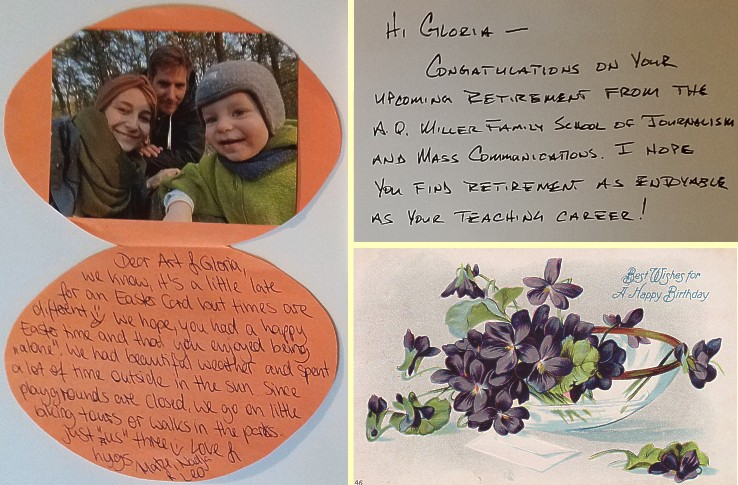Kansas Snapshots by Gloria Freeland - June 12, 2020
"Messenger of Sympathy and Love ..."
While husband Art and I enjoy many of the same things, we also differ on some. One of those differences is mail. He drives right by
our roadside mailbox and only checks his work P.O. Box if he’s expecting a check.
In contrast, I look forward to the arrival of the newspaper from my hometown and another from a village nearby. Occasional hand-written
notes and greeting cards also make me happy.
I like to send mail too. I recently posted a card to a friend's father, who turned 95, and sympathy cards to family and friends who
lost loved ones. Posting a birthday tweet, putting a condolence message on Facebook or communicating through online message boards just
doesn't do it for me.
The words, "Neither snow nor rain nor heat nor gloom of night stays these couriers from the swift completion of their appointed rounds,"
are cut into the gray granite over the New York City Post Office on 8th Avenue. One of the building’s architects, William Mitchell
Kendall, read Greek for pleasure and took the words from "The Persian Wars" by Herodotus. I doubt Wayne, our mail carrier, is Greek,
but he has been true to those words for years. When roads were icy and I didn’t want to get "out and about," he still made it to
our home.
Because of "social distancing," I've been relying on him even more now. I've left notes asking if I owe more money on letters that
seem a bit thicker or heavier than one stamp will cover. When I'm short, he leaves a little brown envelope that lists what I owe him.
It is the kind of service our rural mail carriers also offered when I was growing up.
Delivering mail in the city was - and still is - a little different. My uncle Bud was a city mail carrier in Council Grove, Kansas,
as was his father Oliver, who used a horse-drawn wagon. Art's second cousin Donnie was also a city mail carrier. He recently explained
that clerks sorted the incoming mail that arrived by train - now by truck or plane - into city zones. Then zone carriers like him
sorted the mail by street address using a case with pigeon holes. He then bundled the mail in the order he would walk the route.
When he first started in 1948, he took a city bus with the bundle for those at the start of his route in his shoulder bag. Meanwhile,
the other bundles were delivered to relay stations along his route. The first relay box was located near where the addresses in the
first bundle ended. He'd reload his bag and continue this pattern until he completed his 12-mile daily route. Many relay boxes were
needed because there was a lot of mail and magazines in those days. Later on, carriers used three-legged carts to save wear and tear
on their shoulders. Today, carriers are assigned the small vehicles we see parked in neighborhoods. These vehicles replaced the relay
boxes and the need for others to fill them.
Donnie turned 92 recently, and Art's aunt Sue said he's in great shape.
"I always attribute his good health to the fact he walked all those miles through those earlier post office years and got the kind of
exercise that kept him in such good health today," she said.
In my Post P.O. column of 2011, I mentioned how technology and competition were affecting the postal
service. This year, it is projected to lose billions. It was made an independent government corporation with the intent of getting
politics out of its operation. But in 2006, Congress required the service to pre-fund its health benefits 75 years into the future.
This was to assure that retired employees would get a pension even if the service dissolved. But it is a requirement almost impossible
to meet with declining usage.
Yet millions of Americans still depend on mail service for such things as their Social Security checks, prescriptions, vital
communications, and other services. Many people may choose to vote via mail-in ballot this year because of COVID-19 concerns.
Regardless of what the future holds, I think fondly of what it once meant to so many. The building that formerly was the Washington,
D.C. Post Office is now the home of the Smithsonian Institution’s National Postal Museum. Carved in white granite are the words of
"The Letter," written by Charles W. Eliot, former president of Harvard University. President Woodrow Wilson changed the text slightly
and the result expresses well what the service meant - and still means - to so many of us.
Messenger of Sympathy and Love
Servant of Parted Friends
Consoler of the Lonely
Bond of the Scattered Family
Enlarger of the Common Life
Carrier of News and Knowledge
Instrument of Trade and Industry
Promoter of Mutual Acquaintance
Of Peace and of Goodwill
Among Men and Nations.
